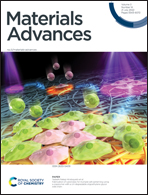Engineering of a self-supported carbon electrode with 2D ultrathin heterostructures of NiCo LDH/NiCoS via a MOF-template for sensitive detection of glucose and H2O2†
Abstract
Reasonable design and development of bifunctional electrodes for glucose and hydrogen peroxide (H2O2) detection are of great significance since glucose and H2O2 levels are important indicators for evaluating environmental and dietary health. In this work, we develop a simple and efficient strategy to fabricate self-supported and low-cost carbon electrodes consisting of two-dimensional (2D) ultrathin heterostructures of NiCo layered double hydroxide (LDH)/NiCoS array nanostructures and a carbon cloth (CC) substrate via a hard template method, exhibiting superior detection performances for glucose and H2O2. A 2D Co MOF is employed as a sacrificial template and a Co source for the growth of NiCo LDH, which can also ensure the anchoring and stability of the nanosheet. Owing to the interface and the 2D ultrathin structure of NiCo LDH/NiCoS, the obtained self-supported carbon electrode shows excellent sensitivities for glucose oxidation (2167 and 1417 μA mM−1 cm−2) and H2O2 reduction (285 μA mM−1 cm−2) with significant anti-interference and a low detection limit. The stronger electronic interaction at the hybrid interface between NiCo LDH and NiCoS facilitates the adsorption of reactants and the desorption of products, and promotes the rapid response of the electrode to glucose and H2O2. Our present work demonstrates an efficient way via a combination of bimetallic sulfides and LDH for improving the electrochemical sensing of electrodes, revealing the significant potential of low-cost bifunctional electrodes with 2D ultrathin nanostructures and a carbon substrate for detection.



 Please wait while we load your content...
Please wait while we load your content...